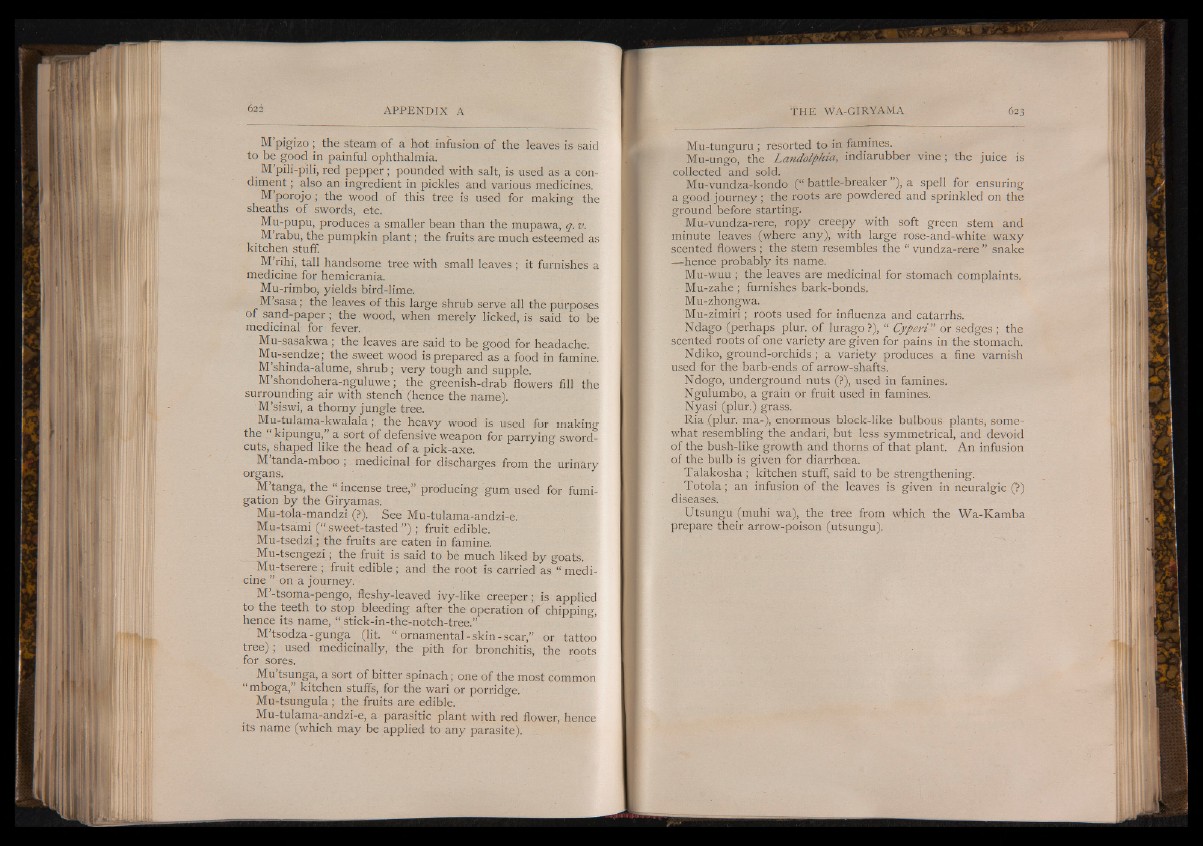
M’pigizo; the steam of a hot infusion of the leaves is said
to be good in painful ophthalmia.
M’pili-pili, red pepper; pounded with salt, is used as a condiment
; also an ingredient in pickles and various medicines.
M’porojo; the wood of this tree is used for making the
sheaths of swords, etc.
Mu-pupu, produces a smaller bean than the mupawa, q. v.
M’rabu, the pumpkin plant; the fruits are much esteemed as
kitchen stuff.
M.rihi, tall handsome tree with small leaves ; it furnishes a
medicine for hemicrania.
Mu-rimbo, yields bird-lime.
M’sasa; the leaves of this large shrub serve all the purposes
of sand-paper; the wood, when merely licked, is said to be
medicinal for fever.
Mu-sasakwa; the leaves are said to be good for headache.
Mu-sendze; the sweet wood is prepared as a food in famine.
M’shinda-alume, shrub; very tough and supple.
M’shondohera-nguluwe; the greenish-drab flowers fill the
surrounding air with stench (hence the name).
M’siswi, a thorny jungle tree.
Mu-tulama-kwalala; the heavy wood is used for making
the “ kipungu,” a sort of defensive weapon for- parrying sword-
cuts, shaped like the head of a pick-axe.
M tanda-mboo ; medicinal for discharges from the urinary
organs.
M’tanga, the “ incense tree,” producing gum used for fumigation
by the Giryamas.
Mu-tola-mandzi (?). See Mu-tijlama-andzi-e.
Mu-tsami (“ sweet-tasted ”) , fruit edible.
Mu-tsedzi; the fruits are eaten in famine.
Mu-tsengezi > the fruit is said to be much liked by goats.
( Mu-tserere | fruit edible ; and the root is carried as “ medicine
” on a journey.
M’-tsoma-pengo, fleshy-leaved ivy-like creeper; is applied
to the teeth to stop bleeding after the operation of chipping,
hence its name, “ stick-in-the-notch-tree.”
M’tsodza - gunga (lit. “ ornamental - skin - scar,” or tattoo
tree); used medicinally, the pith for bronchitis, the roots
for sores.
Mu tsunga, a sort of bitter spinach; one of the most common
“mboga, kitchen stuffs, for the wari or porridge.
Mu-tsungula; the fruits are edible.
Mu-tulama-andzi-e, a parasitic plant with red flower, hence
its name (which may be applied to any parasite).
Mu-tunguru ; resorted to in famines.
Mu-ungo, the L a n d o lp h ia , indiarubber vine; the juice is
collected and sold.
Mu-Vundza-kondo (“ battle-breaker ”), a spell for ensuring
a good journey; the roots are powdered and sprinkled on the
ground before starting.
Mu-vundza-rere, ropy creepy with soft green stem and
minute leaves (where any), with large rose-and-white waxy
scented flowers ; the stem resembles the “ vundza-rere ” snake
— hence probably its name.
Mu-wuu ; the leaves are medicinal for stomach complaints.
Mu-zahe; furnishes bark-bonds.
Mu-zhongwa.
Mu-zimiri; roots used for influenza and catarrhs.
Ndago (perhaps plur. of lurago ?), 8 Cyperi” or sedges ; the
scented roots of one variety are given for pains in the stomach.
Ndiko, ground-orchids; a variety produces a fine varnish
used for the barb-ends of arrow-shafts.
Ndogo, underground nuts (?), used in famines.
Ngulumbo, a grain or fruit used in famines.
Nyasi (plur.) grass.
Ria (plur. ma-), enormous block-like bulbous plants, somewhat
resembling the andari, but less symmetrical, and devoid
of the bush-like growth and thorns of that plant. An infusion
of the bulb is given for diarrhoea.
Talakosha ; kitchen stuff, said to be strengthening.
Totola; an infusion of the leaves is given in neuralgic (?)
diseases.
Utsungu (muhi wa), the tree from which the Wa-Kamba
prepare their arrow-poison (utsungu).